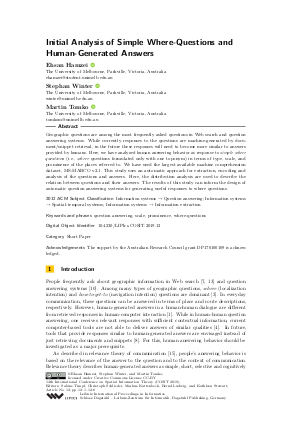Initial Analysis of Simple Where-Questions and Human-Generated Answers (Short Paper)
Authors
Ehsan Hamzei  ,
Stephan Winter
,
Stephan Winter  ,
Martin Tomko
,
Martin Tomko 
-
Part of:
Volume:
14th International Conference on Spatial Information Theory (COSIT 2019)
Part of: Series: Leibniz International Proceedings in Informatics (LIPIcs)
Part of: Conference: Conference on Spatial Information Theory (COSIT) - License:
 Creative Commons Attribution 3.0 Unported license
Creative Commons Attribution 3.0 Unported license
- Publication Date: 2019-09-03
File

PDF
LIPIcs.COSIT.2019.12.pdf
- Filesize: 429 kB
- 8 pages
Document Identifiers
Subject Classification
ACM Subject Classification
- Information systems → Question answering
- Information systems → Spatial-temporal systems
- Information systems → Information extraction
Keywords
- question answering
- scale
- prominence
- where-questions
Metrics
- Access Statistics
-
Total Accesses (updated on a weekly basis)
0PDF Downloads0Metadata Views
Abstract
Geographic questions are among the most frequently asked questions in Web search and question answering systems. While currently responses to the questions are machine-generated by document/snippet retrieval, in the future these responses will need to become more similar to answers provided by humans. Here, we have analyzed human answering behavior as response to simple where questions (i.e., where questions formulated only with one toponym) in terms of type, scale, and prominence of the places referred to. We have used the largest available machine comprehension dataset, MS-MARCO v2.1. This study uses an automatic approach for extraction, encoding and analysis of the questions and answers. Here, the distribution analysis are used to describe the relation between questions and their answers. The results of this study can inform the design of automatic question answering systems for generating useful responses to where questions.
Cite As Get BibTex
Ehsan Hamzei, Stephan Winter, and Martin Tomko. Initial Analysis of Simple Where-Questions and Human-Generated Answers (Short Paper). In 14th International Conference on Spatial Information Theory (COSIT 2019). Leibniz International Proceedings in Informatics (LIPIcs), Volume 142, pp. 12:1-12:8, Schloss Dagstuhl – Leibniz-Zentrum für Informatik (2019)
https://doi.org/10.4230/LIPIcs.COSIT.2019.12
BibTex
@InProceedings{hamzei_et_al:LIPIcs.COSIT.2019.12,
author = {Hamzei, Ehsan and Winter, Stephan and Tomko, Martin},
title = {{Initial Analysis of Simple Where-Questions and Human-Generated Answers}},
booktitle = {14th International Conference on Spatial Information Theory (COSIT 2019)},
pages = {12:1--12:8},
series = {Leibniz International Proceedings in Informatics (LIPIcs)},
ISBN = {978-3-95977-115-3},
ISSN = {1868-8969},
year = {2019},
volume = {142},
editor = {Timpf, Sabine and Schlieder, Christoph and Kattenbeck, Markus and Ludwig, Bernd and Stewart, Kathleen},
publisher = {Schloss Dagstuhl -- Leibniz-Zentrum f{\"u}r Informatik},
address = {Dagstuhl, Germany},
URL = {https://drops.dagstuhl.de/entities/document/10.4230/LIPIcs.COSIT.2019.12},
URN = {urn:nbn:de:0030-drops-111049},
doi = {10.4230/LIPIcs.COSIT.2019.12},
annote = {Keywords: question answering, scale, prominence, where-questions}
}
Author Details
Acknowledgements
The support by the Australian Research Council grant DP170100109 is acknowledged.
References
- Christine Doran, John Aberdeen, Laurie Damianos, and Lynette Hirschman. Comparing Several Aspects of Human-Computer and Human-Human Dialogues, pages 133-159. Springer Netherlands, Dordrecht, 2003. URL: https://doi.org/10.1007/978-94-010-0019-2_7.
-
Ehsan Hamzei, Haonan Li, Maria Vasardani, Timothy Baldwin, Stephan Winter, and Martin Tomko. Place questions and human-generated answers: A data analysis approach. In Geospatial Technologies for Local and Regional Development, pages 1-16, 2019.

- Andreas Henrich and Volker Luedecke. Characteristics of Geographic Information Needs. In Proceedings of the 4th ACM Workshop on Geographical Information Retrieval, GIR '07, pages 1-6, New York, NY, USA, 2007. ACM. URL: https://doi.org/10.1145/1316948.1316950.
-
Lynette Hirschman and Robert Gaizauskas. Natural language question answering: the view from here. Natural Language Engineering, 7(4):275-300, 2001.

-
G. F. Jenks. The Data Model Concept in Statistical Mapping. International Yearbook of Cartography, 7:186-190, 1967.

-
Karen Sparck Jones. Retrieving information or answering questions? London : British Library. (British Library Annual Research Lecture ; 8), 1990.

- Emilia Kacprzak, Laura Koesten, Jeni Tennison, and Elena Simperl. Characterising Dataset Search Queries. In Companion Proceedings of the The Web Conference 2018, WWW '18, pages 1485-1488, Geneva, Switzerland, 2018. International World Wide Web Conferences Steering Committee. URL: https://doi.org/10.1145/3184558.3191597.
- Oleksandr Kolomiyets and Marie-Francine Moens. A survey on question answering technology from an information retrieval perspective. Information Sciences, 181(24):5412-5434, 2011. URL: https://doi.org/10.1016/j.ins.2011.07.047.
- Jochen L. Leidner, Gail Sinclair, and Bonnie Webber. Grounding Spatial Named Entities for Information Extraction and Question Answering. In Proceedings of the HLT-NAACL 2003 Workshop on Analysis of Geographic References - Volume 1, HLT-NAACL-GEOREF '03, pages 31-38, Stroudsburg, PA, USA, 2003. Association for Computational Linguistics. URL: https://doi.org/10.3115/1119394.1119399.
-
Xin Li and Dan Roth. Learning question classifiers: the role of semantic information. Natural Language Engineering, 12(3):229-249, 2006.

-
Tri Nguyen, Mir Rosenberg, Xia Song, Jianfeng Gao, Saurabh Tiwary, Rangan Majumder, and Li Deng. MS MARCO: A human generated machine reading comprehension dataset. arXiv preprint arXiv:1611.09268, 2016.

- Daniela Richter, Stephan Winter, Kai-Florian Richter, and Lesley Stirling. Granularity of locations referred to by place descriptions. Computers, Environment and Urban Systems, 41:88-99, 2013. URL: https://doi.org/10.1016/j.compenvurbsys.2013.03.005.
-
Mark Sanderson and Janet Kohler. Analyzing geographic queries. In SIGIR Workshop on Geographic Information Retrieval, volume 2, pages 8-10, 2004.

-
Benny Shanon. Answers to where-questions. Discourse Processes, 6(4):319-352, 1983.

-
Deirdre Wilson and Dan Sperber. Relevance theory. In Handbook of Pragmatics. Blackwell, 2002.

